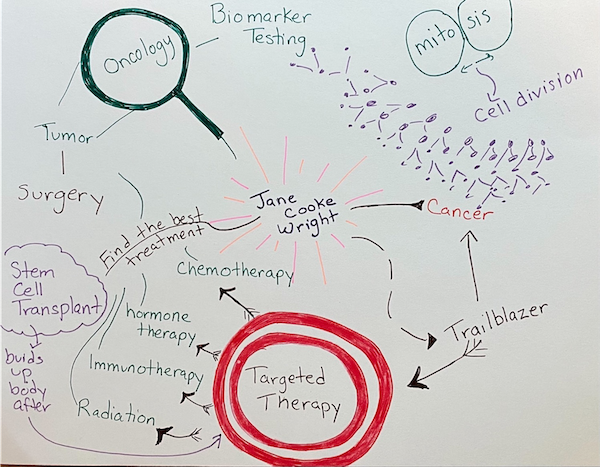Summary
This lesson is part of the "Woman Crush Wednesday" series that looks at the ways female scientists have shaped our views of science. In this biology lesson, students will explore the many contributions of Jane Cooke Wright, with special attention on her study of the impact of uncontrolled cell division during mitosis and cancer types and treatments. This lesson extends students' understanding of mitosis through real world applications. Students should have knowledge of the process of cellular division prior to this lesson.
Essential Question(s)
What happens when there is uncontrolled cell division during mitosis? How have women in history shaped science today?
Snapshot
Engage
Students discuss what qualities characterize trailblazers and watch a video about the work of physician Jane Cooke Wright.
Explore
Students play a kinesthetic game of tag, which simulates cells that are controlled, uncontrolled, and undergoing treatment.
Explain
Students build vocabulary by using a TIP Chart as they learn about the uncontrolled replication of cells and the field of oncology.
Extend
Students research and create an infographic on cancer treatment options and how these options address the uncontrolled replication of cancer cells.
Evaluate
Students reflect on the impact Jane Cooke Wright’s work has had on modern day cancer treatment options.
Materials
Engage
Introduce the lesson using the attached Lesson Slides. Display slides 3–4 to share the essential questions and lesson objectives as needed.
Display slide 5. Ask the class “What is a trailblazer? Can you think of any trailblazers? What makes those people trailblazers?” Generate a class list of the qualities that characterize a trailblazer. Write answers/lists on the board to refer back to later, if needed.
Move to slide 6. If you have a copy of Women in Science: 50 Fearless Pioneers Who Changed the World by Rachel Ignotofsky, read the Jane Cooke Wright excerpt aloud to students.
Watch the video of real life trailblazer Jane Cooke Wright, which describes her immense contributions to science.
Show Slide 7, which lists the highlights of Jane Cooke Wright’s contributions. Briefly review them with students. Ask students “Now that you’ve identified traits of trailblazers, would you consider Jane Cooke Wright a trailblazer? Why or why not?”
Explore
Display slide 8. Go over the rules of the game before moving outside or to your open space:
To better understand the effects of the uncontrolled division of cancer cells, take students to an open space to engage in the following tagging game that simulates cell division.
Start Round One like a normal tagging game with one tagger.
Explain that this tagger is an abnormal cell that is replicating out of control. Every time a new person is tagged they become a replicating cell and can start tagging too.
Set a time limit based on your class size.
Play Round One of the game once or twice.
Discuss what they noticed and felt as taggers or “cells” that began to replicate.
Describe instructions for Round Two:
Designate 3-5 students, depending on the size of your class, as “Treatment.”
Assign “Treatment” taggers to tag the taggers (the cells replicating out of control).
Let students know that “Treatment” taggers cannot be tagged themselves.
Before Round Two begins, announce that, when a “Treatment” tagger tags one of the “out of control cells,” that person has to freeze and can no longer tag others.
Have students play Round Two once or twice. When you think it is time to end the game, ask the students the following questions:
What did you notice about each of the two rounds?
Were the “Treatment” taggers able to able to stop all of the “out of control cells?”
Were some “out of control cells” able to evade treatment?
How did the students being chased by the taggers feel knowing that the “Treatment” students could stop the “replicating cell” students?
Display slide 9. Ask students to use the prompts on the slide to discuss what happened in both rounds of tag. Encourage them to see the connection between the tagging game and what happens when cancer cells begin to replicate. Ask them to connect treatment group (in the game) with the technology Jane Cooke Wright worked on to attack rapidly growing cells.
Explain
Display slide 10. Explain the TIP chart strategy. Pass out copies of the Tip Chart handout or have students write on their own paper using the example on the slide.
Display slide 11. Show The Amoeba Sisters’ video “The Cell Cycle (and Cancer)”. You only need to show the first 3:30 of the video, but feel free to show more if students are interested and time allows.
As students watch, have them complete the I (information) column. You may choose to pause the video after each term and allow students to fill in the column.
Cell cycle: 0:55
Cell division: 1:19
Mitosis: 1:36
Cancer: 1:59
Tumor: 3:01
Radiation/chemotherapy: 3:12
Allow students time to complete the P (picture) column. You may want to use the TIP Chart as the students’ Exit Ticket.
Extend
Assign students to create their own infographic. Have them review their own research to gather information to incorporate into their infographic.
Display slide 12. Put students in groups of 3-4. Assign groups to select one of the eight forms of cancer treatment listed on the slide. If you allow groups to pick, make sure that all of the treatment forms are covered.
Invite students to use their own devices to link to the cancer.gov site using the QR code on the slide. Encourage groups to explore additional resources. This site provides information about how treatments address replicating cells and should be required as a source for all groups.
Hand out the Infographic Checklist and explain to groups the expectations for content and layout of their original infographic. Give students time to create their infographic.
Evaluate
Display infographics in the classroom or school hallway.
Show slide 13. Have students take a Gallery Walk of their classmates’ infographics.
Once they have viewed all of the infographics, let them know that their next task is to create a Mind Map. Have students create their Mind Map on a sheet of paper. Instruct them to use Jane Cooke Wright as the main idea in the center of the map.
Have them include ten of the following words as the surrounding ideas: biomarker testing, cancer, cell division, chemotherapy, hormone therapy, immunotherapy, mitosis, oncology, radiation, stem cell transplant, surgery, targeted therapy, tumor, trailblazer.

Resources
Amoeba Sisters. (2018, Mar 20). The cell cycle (and cancer). [Video]. YouTube. https://www.youtube.com/watch?v=QVCjdNxJreE
ConquerCancerFdtn. (2011, June 21). Paying tribute to ASCO founder Jane C. Wright, MD. [Video]. https://www.youtube.com/watch?v=6hHiWeki9GE
Emory University-CancerQuest. (2013, Oct 2). Animated introduction to cancer biology. [Video]. YouTube. https://www.youtube.com/watch?v=46Xh7OFkkCE
Hibrida. (2020). Black history month firsts. Stock.adobe.com. [Digital image]. http://www.mycitymag.com/black
Ignotofsky, R. (2016). Women in science: 50 fearless pioneers who changed the world. New York. Potter/TenSpeed/Harmony.
K20 Center. (n.d.). Bell Ringers and Exit Tickets. Strategies. https://learn.k20center.ou.edu/strategy/125
K20 Center. (n.d.). Canva. Tech Tools. https://learn.k20center.ou.edu/tech-tool/612
K20 Center. (n.d.). Gallery Walk/Carousel. Strategies. https://learn.k20center.ou.edu/strategy/118
K20 Center. (n.d.). Mind Map. Strategies. https://learn.k20center.ou.edu/strategy/1277
K20 Center. (n.d.). Piktochart. Tech Tools. https://learn.k20center.ou.edu/tech-tool/2394
K20 Center. (n.d.). TIP Chart. Strategies. https://learn.k20center.ou.edu/strategy/185
Large, H. (2020, Mar 8). Jane C. Wright: The woman who changed the landscape of oncology. [Digital image]. Technology Networks. https://www.technologynetworks.com/tn/articles/jane-c-wright-the-woman-who-changed-the-landscape-of-oncology-331263
National Cancer Institute. (n.d.) Types of cancer treatment. [Website]. https://www.cancer.gov/about-cancer/treatment/types
Schaferle. (2017). Man DNA Spiral. [Digital image]. Pixabay. https://pixabay.com/illustrations/man-dna-spiral-biology-merge-2125123/
Stanford University. (2015). Stanford biologists crack centuries-old mystery of how cell growth triggers cell division. [Digital image]. https://biox.stanford.edu/highlight/stanford-biologists-crack-centuries-old-mystery-how-cell-growth-triggers-cell-division
Thrasher, J. (2021, Feb 24). Celebrating Black History Month - Jane Cooke Wright. Molecular Biophysics and Biochemistry. https://mbb.yale.edu/news/celebrating-black-history-month-jane-cooke-wright


